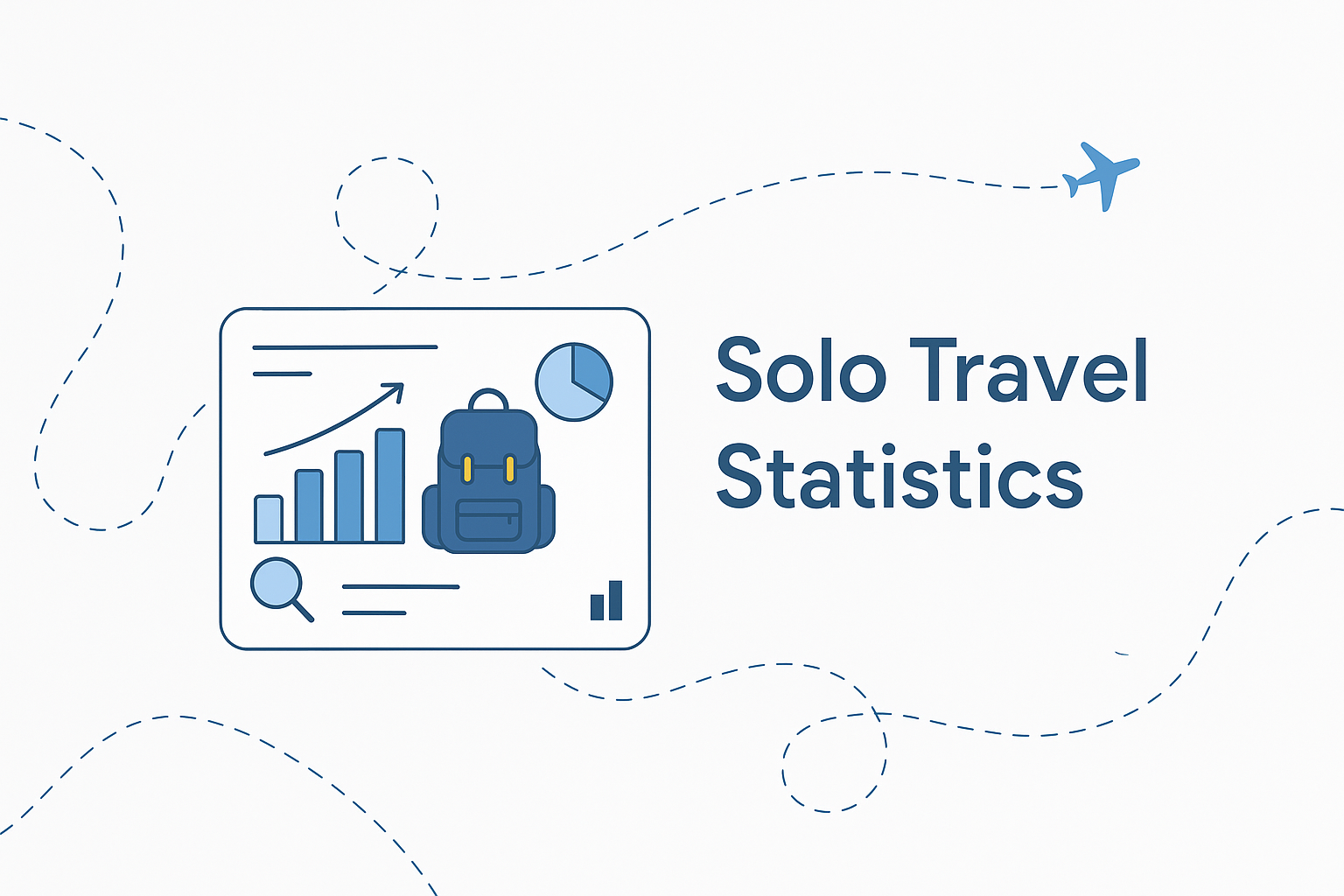Solo travel has shifted from being a niche activity to a major travel trend worldwide. Whether for personal growth, adventure, or simply the joy of traveling at one’s own pace, more people are choosing to hit the road alone than ever before.
In this article, we’ll explore the latest statistics and trends shaping solo travel in 2025 — from who’s going solo, to the destinations they choose, and how social media fuels the movement.
Top Solo Travel Stats – Editor’s Picks
Here are the most eye-catching numbers from our research:
- Interest in solo travel has surged — Google searches rose by 131% between 2016 and 2019, quadrupled again by 2022, and hashtags like #solotravel grew over tenfold.
- Women dominate the market, making up between 75% and 85% of all solo travelers.
- The solo travel market is growing fast, projected to expand at 9.1% annually from 2023 to 2030, and now representing about 11% of all global travel.
- Adventure travel is popular — 47% of solo travelers choose activities like hiking, cycling, or diving.
- Most solo travelers are in their 30s and 40s, with 25% aged 30–39 and 20% aged 40–49.
- Typical spending ranges from $1,000 to $3,000 per trip, but 16% spend over $3,000 on luxury experiences.
- Safety perceptions are mixed — 59% of female solo travelers feel safe, but 76% say they would feel unsafe in certain contexts.
What Are the Most Impressive Solo Travel Statistics in 2025?
Solo travel is no longer a fringe activity — it’s a mainstream travel segment with strong momentum.
- Interest has more than doubled since before 2021, with a quarter of all travelers now planning a solo trip in the next year.
- Solo travel accounts for around 11% of global travel and is on track for steady expansion.
- Nearly half of solo travelers take three or more trips per year, indicating strong loyalty to the lifestyle.
Travel companies and destinations have a growing incentive to offer packages, tours, and experiences tailored to solo explorers.
How Fast Is Solo Travel Growing Around the World?
The solo travel market is expanding quickly, backed by both consumer demand and industry adaptation.
- Expected to grow at 9.1% annually between 2023 and 2030.
- Countries like the UK have seen a 42% rise in solo travel bookings in just two years.
- A growing acceptance of solo travel as a form of self-care and independence is pushing adoption rates higher.
Tourism boards and brands that adapt early will have a competitive edge.
Who Is Traveling Solo the Most?
Who is driving the solo travel boom?
- Women make up as much as 84% of solo travelers in some surveys.
- 25% of solo travelers are aged 30–39, 20% are in their 40s, 19% are in their 50s, and 17% are 18–29.
- In the UK, 24% of Brits plan to travel alone this year.
- 72% of American women have taken a solo journey, topping global rankings.
Marketing campaigns that reflect the diversity of solo travelers — especially women and younger generations — are likely to resonate.
Is Solo Travel Safe and Which Destinations Stand Out?
Safety is both a motivator and a concern for solo travelers.
- 59% of women feel safe traveling solo, but 76% say they would avoid certain destinations due to safety concerns.
- Poland ranks among the top 10 safest destinations for solo travelers, thanks to strong security measures.
Safety certifications and clear travel advisories can influence destination choice.
How Much Do Solo Travelers Spend and Why Do They Travel?
Understanding solo travel budgets and motivations reveals a diverse market.
- 55% of solo travelers spend between $1,000 and $3,000 per trip, 29% spend under $1,000, and 16% invest $3,000+ in luxury experiences.
- 66% travel solo for freedom and flexibility, 39% for cultural immersion, 25% for adventure, and 18% for wellness or personal growth retreats.
- 47% of solo travelers engage in adventure travel such as hiking, cycling, or diving, and 16% participate in volunteering or work exchange programs.
The solo travel market is diverse, spanning budget-conscious backpackers, adventure seekers, and high-spending luxury travelers.
How Is Social Media Influencing Solo Travel?
Social platforms are turbocharging solo travel’s popularity.
- The hashtag #solotravel has over 7.9 million Instagram posts.
- Terms like “solo travel deals” and “best solo destinations” saw a 30% increase in 2024.
- Social content encourages more travelers to try solo trips, which in turn fuels more content creation.
Platforms like Instagram and TikTok are as influential as traditional travel guides in shaping traveler decisions.
FAQ
What percentage of travelers go solo?
Around 11% of global travelers are solo travelers, and this share is steadily rising.
Are most solo travelers women?
Yes. Women account for 75–85% of all solo travelers, depending on the survey.
Which age group travels solo the most?
Travelers aged 30–39 lead the way, followed closely by those in their 40s and 50s.
How much do solo travelers spend on average?
Most spend $1,000–$3,000 per trip, though budget and luxury segments are both growing.
Why do people travel solo?
Top reasons include freedom, flexibility, cultural immersion, adventure, and wellness.
Which destinations are safest for solo travelers?
Poland is consistently ranked among the safest, with other safe choices including Nordic and Western European countries.
Conclusion
Solo travel is no longer a niche — it’s a growing, dynamic part of the global tourism market. With women leading the movement, strong social media influence, and a projected multi-year growth trend, the future of solo travel looks bright.
For destinations, tour operators, and travel brands, this is more than a passing fad — it’s a market segment worth investing in.



0 Comment